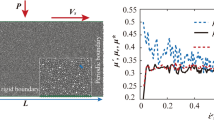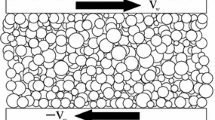Abstract
The rheological properties of granular matter submitted to torsional shear are investigated numerically by means of discrete element method. The shear cell is made of a cylinder filled by grains which are sheared by a bumpy bottom and submitted to a vertical pressure which is applied at the top. Regimes differing by their strain localization features are observed. They originate from the competition between dissipation at the sidewalls and dissipation in the bulk of the system. The effects of the (i) the applied pressure, (ii) sidewall friction, and (iii) angular velocity are investigated. A model, based on the purely local \(\mu (I)\)-rheology and a minimum energy principle is able to capture the effect of the two former quantities but unable to account the effect of the latter. Although, an ad hoc modification of the model allows to reproduce all the numerical results, our results point out the need for an alternative rheology.













Similar content being viewed by others
References
Artoni R, Santomaso A (2014) Effective wall slip in chutes and channels: experiments and discrete element simulations. Granul Matter 16(3):377–382
Nedderman R, Laohakul C (1980) The thickness of the shear zone of flowing granular materials. Powder Technol 25(1):91–100
Natarajan VVR, Hunt ML, Taylor ED (1995) Local measurements of velocity fluctuations and diffusion coefficients for a granular material flow. J Fluid Mech 304:1–25
Midi GDR (2004) On dense granular flows. Eur Phys J E 14(4):341–365
Singh A, Magnanimo V, Saitoh K, Luding S (2014) Effect of cohesion on shear banding in quasistatic granular materials. Phys Rev E 90:022,202
Singh A, Magnanimo V, Saitoh K, Luding S (2015) The role of gravity or pressure and contact stiffness in granular rheology. N J Phys 17(4):043,028
Moosavi R, Shaebani MR, Maleki M, Török J, Wolf DE, Losert W (2013) Coexistence and transition between shear zones in slow granular flows. Phys Rev Lett 111:148,301
Fenistein D, van Hecke M (2003) Kinematics: wide shear zones in granular bulk flow. Nature 425(6955):256–256
Jop P (2008) Hydrodynamic modeling of granular flows in a modified couette cell. Phys Rev E 77:032,301
da Cruz F, Emam S, Prochnow M, Roux JN, Chevoir FMC (2005) Rheophysics of dense granular materials: discrete simulation of plane shear flows. Phys Rev E 72:021,309
Jop P, Forterre Y, Pouliquen O (2006) A constitutive law for dense granular flows. Nature 441:727–730
Cortet PP, Bonamy D, Daviaud F, Dauchot O, Dubrulle B, Renouf M (2009) Relevance of visco-plastic theory in a multi-directional inhomogeneous granular flow. Europhys Lett 88(1):14,001
Brodu N, Richard P, Delannay R (2013) Shallow granular flows down flat frictional channels: steady flows and longitudinal vortices. Phys Rev E 87:022,202
Kamrin K, Koval G (2012) Nonlocal constitutive relation for steady granular flow. Phys Rev Lett 108:178,301
Henann DL, Kamrin K (2013) A predictive, size-dependent continuum model for dense granular flows. Proc Natl Acad Sci USA 110(17):6730–6735
Kamrin K, Henann DL (2015) Nonlocal modeling of granular flows down inclines. Soft Matter 11:179–185
Henann DL, Kamrin K (2014) Continuum modeling of secondary rheology in dense granular materials. Phys Rev Lett 113:178,001
Jenkins J, Berzi D (2010) Dense inclined flows of inelastic spheres: tests of an extension of kinetic theory. Granul Matter 12:151–158
Jenkins J, Berzi D (2012) Kinetic theory applied to inclined flows. Granul Matter 14:79–84. doi:10.1007/s10035-011-0308-x
Artoni R, Santomaso A, Canu P (2011) Hysteresis in a hydrodynamic model of dense granular flows. Phys Rev E 83:051,304
Jean M (1999) The non-smooth contact dynamics method. Comput Methods Appl Mech Eng 177(3–4):235–257
Renouf M, Dubois F, Alart P (2004) A parallel version of the non smooth contact dynamics algorithm applied to the simulation of granular media. J Comput Appl Math 168(1–2):375–382. Selected papers from the second international conference on advanced computational methods in engineering (ACOMEN 2002)
Dippel S, Wolf D (1999) Molecular dynamics simulations of granular chute flow. Comput Phys Commun 121:284–289. In: Proceedings of the europhysics conference on computational physics CCP 1998
Glasser BJ, Goldhirsch I (2001) Scale dependence, correlations, and fluctuations of stresses in rapid granular flows. Phys Fluids 13(2):407–420
Babic M (1997) Average balance equations for granular materials. Int J Eng Sci 35(5):523–548
Zhu HP, Yu AB (2002) Averaging method of granular materials. Phys Rev E 66:021,302
Weinhart T, Thornton A, Luding S, Bokhove O (2012) From discrete particles to continuum fields near a boundary. Granul Matter 14:289–294
Artoni R, Richard P (2015) Average balance equations, scale dependence, and energy cascade for granular materials. Phys Rev E 91:032,202
Weinhart T, Hartkamp R, Thornton AR, Luding S (2013) Coarse-grained local and objective continuum description of three-dimensional granular flows down an inclined surface. Phys Fluids 25(7):070605
Luding S (2008) Constitutive relations for the shear band evolution in granular matter under large strain. Particuology 6(6):501–505
Artoni R, Richard P (2015) Effective wall friction in wall-bounded 3d dense granular flows. Phys Rev Lett 115:158,001
Koval G, Roux JN, Corfdir A, Chevoir FMC (2009) Annular shear of cohesionless granular materials: from the inertial to quasistatic regime. Phys Rev E 79:021,306
Staron L, Lagrée PY, Popinet S (2014) Continuum simulation of the discharge of the granular silo. Eur Phys J E 37(1):1–12
Byron Bird R, Stewart WE, Lightfoot EN (2007) Transport phenomena, 2nd edn. Wiley, New York
Unger T, Török J, Kertész J, Wolf DE (2004) Shear band formation in granular media as a variational problem. Phys Rev Lett 92:214,301
Orlando A, Shen H (2013) Using the annular shear cell as a rheometer for rapidly sheared granular materials: a dem study. Granul Matter 15:1–12
Acknowledgments
The numerical simulations were carried out at the CCIPL (Centre de Calcul Intensif des Pays de la Loire) under the project MTEEGD.
Author information
Authors and Affiliations
Corresponding author
Rights and permissions
About this article
Cite this article
Artoni, R., Richard, P. Torsional shear flow of granular materials: shear localization and minimum energy principle. Comp. Part. Mech. 5, 3–12 (2018). https://doi.org/10.1007/s40571-016-0143-2
Received:
Revised:
Accepted:
Published:
Issue Date:
DOI: https://doi.org/10.1007/s40571-016-0143-2




